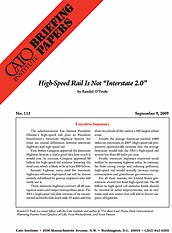First, before Congress approved the Interstate Highway System, it had a good idea how much it would cost. In contrast, Congress approved $8 billion for high-speed rail without knowing the total cost, which is likely to be at least $90 billion.
Second, highway users paid for interstate highways, whereas high-speed rail will be almost entirely subsidized by general taxpayers who will rarely use it.
Third, interstate highways connect all 48 contiguous states and major metropolitan areas. The FRA’s high-speed rail plan consists of six unconnected networks that reach only 33 states and less than two-thirds of the nation’s 100 largest urban areas.
Fourth, the average American traveled 4,000 miles on interstates in 2007. High-speed rail proponents optimistically estimate that the average American would ride the FRA’s high-speed rail system less than 60 miles per year.
Finally, interstate highways improved social welfare by increasing highway safety. In contrast, far from saving energy and reducing pollution, high-speed rail would actually increase energy consumption and greenhouse gas emissions.
For all these reasons, the United States government should not fund high-speed rail. The $8 billion in high-speed rail stimulus funds should be invested in safety improvements, not in new trains and new routes that will add to future taxpayer obligations.


